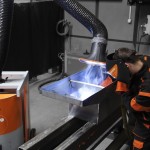Hazardous substances such as welding fumes can harm employees
Particles in the air at the workplace are amongst the complex hazards for employees’ health. This has been shown by a new analysis of the Public German Federal Institute. According to the study, around 6,000 cases of dust related respiratory illnesses are recognized as an occupational disease every year. They are caused by exposure to gases, vapours or hazardous substances such as welding fumes.
The Authority has analysed a representative employee survey from 2012. According to the survey, every eighth employee is exposed to different hazardous substances at work – and frequently so.
Full time employed men (16 %) come into contact with hazardous substances far more frequently than women (9 %). Every second person surveyed in this group feels negatively affected by this. Coughs, skin irritations and a running nose are amongst the complaints which occur amongst those concerned significantly more often than amongst those employees which only rarely come into contact with these hazardous substances.
Around 6,000 dust related respiratory illnesses are recognised as an occupational illness every year according to the BAuA report “Health and Safety at Work 2014”. Dust can still endanger health even when it does not contain hazardous chemicals. Ultra-fine particles are particularly dangerous when they get into fine pulmonary alveoli. Inflammatory illnesses and even cancer can be the result of regular exposure to invisible particles. According to BAuA, even large dust particles can penetrate the lung and may cause damage to nose, throat and pharynx.
Employees with low qualification are often more exposed
At the same time, the analysis shows a connection between level of education and exposure to hazardous substances. Almost every fifth (19 %) employee without or with lower school leaving certification is frequently exposed to dust, smoke etc. When questioning those with a higher level education, it is only every 25th employee (4 %).
A further difference can be found in the working hours: 26 % of those concerned work in shifts including night shifts; on the other hand only 19% of the shift workers without night shift are exposed to dusts. According to BAuA this difference may be due to cleaning and maintenance of machines which is mostly carried out in the evenings or at night.
The sector in which the employees work is crucial with regards to dust exposure. Employees in the construction sector (29 %), in agriculture, forestry and fishing (22 %) and in manufacturing (19 %) are disproportionally more exposed to dust, fumes, vapours or gases.
Tickly coughs, skin redness, itching are the consequence
The subjective feeling plays an important role during the evaluation of the dust exposure. 22 % of employees who are frequently exposed to dust state that their health is not that good or even bad. 28 % of employees who are exposed to dust, fumes, vapours and gases suffer from coughs – that is more than twice as many as for employees which are never, rarely or only sometimes exposed to dust. Skin irritations or itchiness occur three times as much (24 %).
The BAuA also advises to integrate work protection measures into work processes such as extraction systems and filter systems in order to protect employees from serious harm to their health due to hazardous substances such as dust, fumes, gases and vapours.





